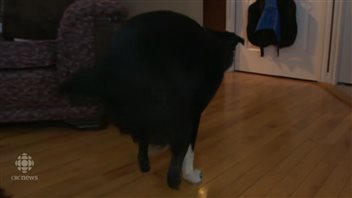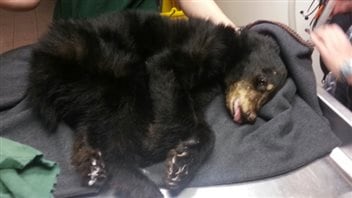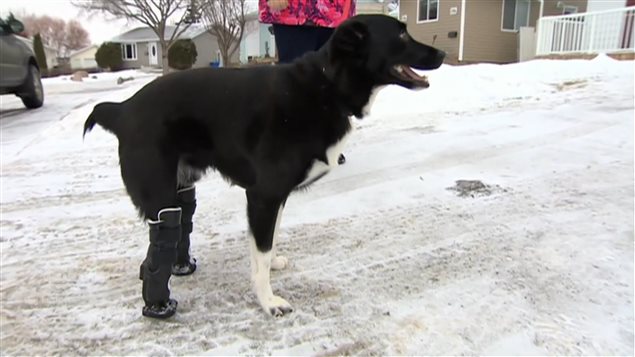Hector the dog was born to a stray mother in northern Saskatchewan. It was a tough start to life, Born in -40 degree temperatures his tail and hind legs became frozen to the ground and were torn off. His tail is now a tufted stump, and his hind legs are gone just below the knee.

Lisa Korol and family in Regina adopted Hector who had learned to walk fairly well balancing on his two front les with his stumps only occasionally touching down. However, they had to keep him indoors at all times to avoid him scraping his hind legs on the ground and getting infected.
Recently a British Columbia company offered to build prosthetics for Hector, and the community in Regina came togetherat fund raising events and outright donations to gather the $4000 needed for the artificial legs.
Korol says Hector now goes outside and is absolutely loving his new legs. For the moment he can only wear them an hour at a time for a total of three hours a day, but has already become a star as he visits schools and rehab clinics for amputees.
Korol says, “He makes everyone smile. If you’re having a bad day, come see Hector”.

In northern Ontario, a young bear cub in distress was found wandering on a road near Wawa. Eventually the cub was transported to the “Wild at Heart” animal refuge centre in Sudbury. Staff there said the young cub probably wouldn’t have lasted much longer in the wild.
They speculate the cub lost his mother in the summer before he was really able to take care of himself. They said the cub normally should weigh around 20-22kg at his age, but weighed less than 8kg.
They also note his front foot bads were badly damaged, probably from desperate digging for food in ice and snow.
The young cub is doing much better now after a few days in care and will be transferred to a bear refuge in southern Ontario familiar with care for black bears.
From Saskatchewan to Ontario, and now to Labrador where some fishermen had a close encounter with curious caribou. Normally caribou are very skittish and clearly avoid coming close to humans.
A couple of fisherman were out near the town of Nain, when a small group of caribou crossed near them, then became curious and came closer.
Reubin Nochasak says they were from the George River caribou herd, whose numbers have dropped by 80 percent in the past few years. Because of that, hunting caribou in the area has been banned for five years. The fishermen think that because of the ban, the caribou might have lost at least a little of their fear of humans.
However, it’s only 2 and a half good news stories as Caribou across Canada continued to be threatened. A new Canadian Parks and Wilderness Society (CPAWS) report says development causing reduction of habitat is outpacing conservation efforts. The report says this is especially so in Alberta where some herd numbers are below the threshold expected for survival.
It cited increased natural gas drilling in British Columbia, vast oil and gas leases in Alberta, and a mine within a provincial park in Manitoba.
For its part, Duncan MacDonnell, of Alberta’s environment and sustainable development department, said the province will release some of its recovery strategies in the next few months, beginning with the herd that is most at risk, the Little Smoky Herd.
The CPAWS report also notes that government austerity measures have meant 50 positions were cut from the caribou recovery department in Quebec whose work has been suspended until sometime next spring, while in Newfoundland/Labrador, the government branch monitoring caribou was shut down and staff laid off or retired.
The Federal Recovery Strategy, released in 2012 under the Species At Risk Act, required the provinces and territories to have recovery plans in place by 2017.
A CPAWS spokesman says recovery planning has proceeded at a snail’s pace and may not be completed on time.
With files from CBC







For reasons beyond our control, and for an undetermined period of time, our comment section is now closed. However, our social networks remain open to your contributions.